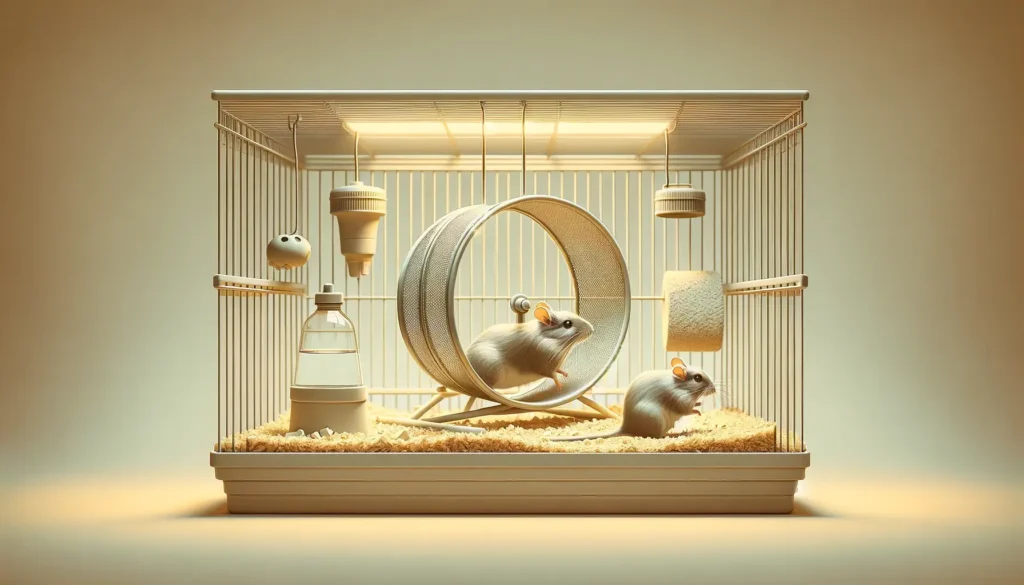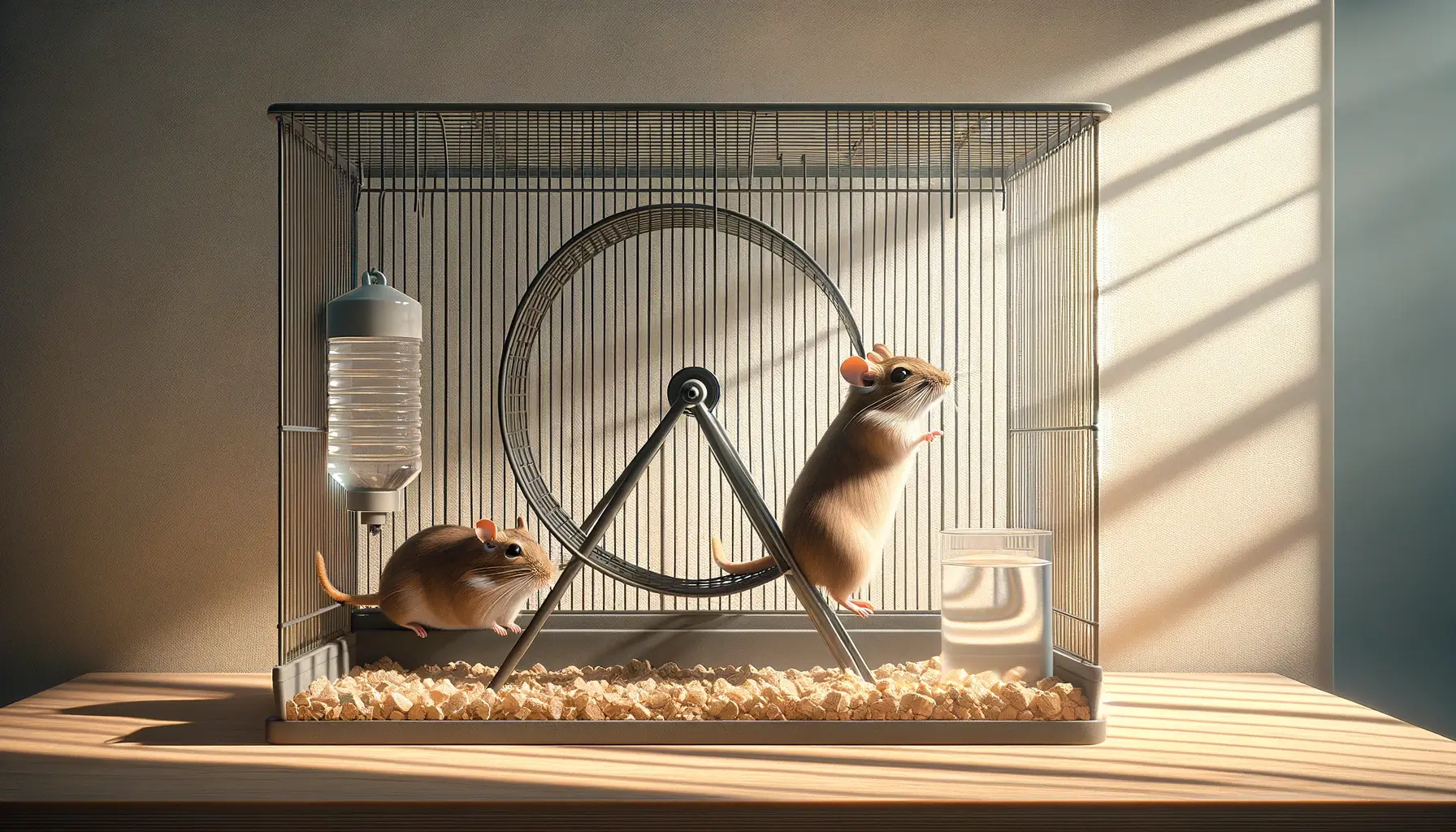Gerbils are charming, inquisitive pets that bring joy and companionship to their human caretakers. These small rodents are known for their playful nature and fascinating behaviors, making them popular choices for pet enthusiasts.
However, like all pets, gerbils have specific needs that must be met to ensure their health and happiness. One of the most crucial aspects of gerbil care is providing an appropriately sized cage.
In this post we will discuss the importance of cage size, understanding gerbils’ needs, and minimum cage size recommendations to help you create the perfect habitat for your furry friends.
Understanding Gerbils’ Housing Needs
To create an ideal environment for gerbils, it’s essential to understand their natural habitat and behaviors. Gerbils are native to arid environments and are adept at digging and tunneling to escape predators and extreme temperatures. This instinctual behavior highlights the need for a cage that allows ample space for burrowing and exploration.
Gerbils are also highly social creatures that thrive in the company of their kind. Keeping gerbils alone can lead to loneliness and stress, underscoring the importance of housing them in pairs or small groups. However, this social arrangement necessitates a larger cage to prevent territorial disputes and ensure each gerbil has enough space to feel secure.
Activity is another critical component of a gerbil’s well-being. These energetic animals require space to run, climb, and play. A cage that’s too small can hinder their ability to engage in these natural behaviors, leading to boredom and potential health issues.
Minimum Cage Size for Gerbils
When it comes to determining the ideal cage size for gerbils, more space is invariably better. The consensus among small animal experts and experienced gerbil owners is that each gerbil should have at least 20 gallons of space.
For a pair of gerbils, this translates to a minimum floor space of 620 square inches. This recommendation is based on the need to accommodate gerbils’ active lifestyles and social nature, allowing for adequate room for exercise, exploration, and comfortable cohabitation.
A cage that’s too small can have several negative effects on gerbils, including stress, depression, and increased aggression. On the other hand, a cage that’s too large can also pose problems, such as declanning, where gerbils begin to view each other as threats, leading to potential fights.
Therefore, while it’s crucial to provide ample space, it’s equally important to ensure the cage is not excessively large for the number of gerbils housed within.
Also read: Can Gerbils Live in Bin Cages?
Creating the Perfect Gerbil Habitat: Cage Features and Setup

When setting up a gerbil cage, it’s not just the size that matters, but also the features within it that cater to their natural instincts and behaviors. A well-thought-out cage setup can significantly enhance your gerbils’ quality of life, providing them with a stimulating environment that mimics their natural habitat.
Essential Cage Features
Deep Bedding for Burrowing: Gerbils have an innate need to dig and burrow. Providing a deep layer of bedding, at least 6-8 inches, allows them to exhibit this natural behavior, which is crucial for their mental and physical well-being. Suitable bedding materials include paper-based products or aspen shavings, which are safe and absorbent.
Secure and Ventilated Lid: A secure lid is essential to prevent escape and protect your gerbils from other household pets. However, it must also allow for adequate ventilation. Mesh or wire lids are ideal, as they provide security while ensuring airflow.
Exercise Wheel: Gerbils are active creatures that benefit from having an exercise wheel. Opt for a solid wheel to prevent tail or foot injuries, ensuring it’s large enough to prevent back bending.
Enrichment Toys: To keep your gerbils entertained and engaged, include a variety of chew toys, tunnels, and hideouts. These not only stimulate their minds but also cater to their chewing needs, keeping their teeth healthy.
Choosing the Right Cage Type and Material
Gerbils can be housed in various types of enclosures, each with its pros and cons. Selecting the right one depends on your specific situation, including space, budget, and the number of gerbils.
Glass Aquariums: A popular choice for gerbil enclosures, glass aquariums are chew-proof and offer excellent visibility. However, they require a mesh top for ventilation and can be heavy to move.
Wire Cages: These provide good ventilation and are lighter than glass tanks. However, they’re not suitable for gerbils due to the risk of chewing through the bars and the mess created by bedding being kicked out.
Plastic Enclosures: While colorful and often coming with built-in tunnels, plastic cages are not recommended as primary habitats for gerbils. They can easily chew through plastic, posing a risk of escape or ingestion of plastic pieces.
FAQs
Can I keep more than two gerbils together?
Yes, gerbils thrive in groups due to their social nature. However, ensure your cage is spacious enough to accommodate them comfortably without overcrowding. Monitor their interactions closely to prevent any potential aggression or territorial disputes.
How often should I clean my gerbil’s cage?
It’s best to perform a thorough cleaning of your gerbil’s cage every 2-3 weeks. However, regular spot cleaning is recommended to remove soiled bedding and uneaten food, maintaining a clean and healthy environment for your pets.
Can gerbils be kept in cages designed for other small animals?
While some cages designed for other small animals can be adapted for gerbils, it’s crucial to ensure they meet gerbils’ specific needs. This includes ample space for burrowing, secure and chew-proof materials, and proper ventilation.
What are the signs my gerbil is unhappy with its cage?
Signs of an unhappy gerbil include excessive chewing on cage bars, lethargy, and changes in social behavior. These behaviors can indicate stress or boredom, suggesting the need for a larger cage or more enrichment activities.
Conclusion
Choosing the right cage size and setup for your gerbils is a critical aspect of their care, directly impacting their health and happiness. By providing a spacious, secure, and enriching environment, you can ensure your gerbils thrive.
Remember, the effort you put into creating a suitable habitat for your gerbils not only enhances their quality of life but also deepens the bond you share with these fascinating creatures.
As responsible pet owners, our goal should always be to mimic their natural habitat as closely as possible, catering to their instinctual needs and behaviors.











